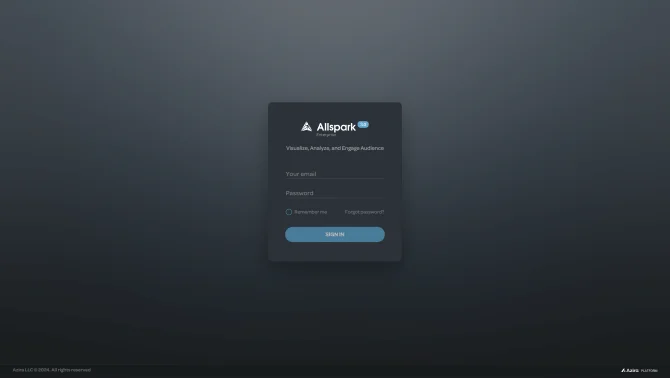Introduction
Allspark is a comprehensive AI platform that offers a suite of tools designed to enhance productivity and efficiency in various fields. Its core offerings include workload orchestration for visual transformers, data comparison tools, and innovative approaches to semi-supervised semantic segmentation. The platform is built with advanced algorithms and user-friendly interfaces, making it accessible for users ranging from academic researchers to industry professionals.
background
Allspark emerges from a need to streamline complex AI tasks, particularly in the realms of computer vision and data analytics. The development of Allspark is backed by a team of experts committed to pushing the boundaries of AI technology, ensuring that the platform remains at the forefront of innovation.
Features of Allspark
Workload Orchestration for Visual Transformers
Allspark optimizes the deployment of visual transformers on processing in-memory (PIM) systems, focusing on minimizing inference latency. It employs fine-grained partitioning and systematic layout to maximize data locality and reduce data movement, formulating scheduling as an integer linear programming problem.
Semi-Supervised Semantic Segmentation
Allspark introduces a novel approach to semi-supervised semantic segmentation, utilizing unlabeled data to enhance labeled feature representation through channel-wise cross-attention. This method improves the quality of pseudo labels, leading to superior results in segmentation tasks.
Data Comparison Tool
Allspark provides a CLI and API-ready data comparison tool that enables users to compare structured datasets in various formats. It offers insights into descriptive statistic differences, aiding in the testing and optimization of ETL flows.
Processing In-Memory Systems
Allspark is designed to work with 3D-stacked DRAM-based PIM systems, demonstrating significant speedups and energy savings over traditional GPUs. It is particularly effective in accelerating memory-intensive operations in transformers.
Channel Semantic Grouping
This feature of Allspark ensures that unlabeled features adequately represent labeled features by grouping channels based on semantic similarity, further enhancing the performance of the segmentation model.
How to use Allspark?
To begin using Allspark, users can follow these steps: 1) Install the necessary Python environment and dependencies as outlined in the documentation. 2) Set up the Allspark environment by cloning the repository and activating the virtual environment. 3) Run the Allspark tool with the appropriate command line arguments or through the API for specific tasks such as workload orchestration or data comparison.
FAQ about Allspark
- How can I install Allspark?
- Follow the installation guide provided in the documentation, which includes cloning the repository and setting up the environment with the required dependencies.
- What are the system requirements for Allspark?
- Allspark requires Python >= 3.6.2 and other dependencies listed in the requirements.txt file. Ensure your system meets these requirements before installation.
- How do I use Allspark for workload orchestration?
- Refer to the specific section in the documentation dedicated to workload orchestration, which provides detailed instructions and examples.
- What is the purpose of the Semantic Memory in Allspark?
- The Semantic Memory in Allspark stores previous unlabeled features, allowing the model to leverage a broader feature space for reconstructing labeled features, thus improving the quality of pseudo labels.
- How can I compare datasets using Allspark?
- Use the data comparison tool provided by Allspark to analyze and compare structured datasets in various formats, providing insights into descriptive statistics and potential discrepancies.
- Is there a graphical user interface for Allspark?
- While Allspark primarily offers CLI and API interfaces, the documentation may provide guidance on how to integrate it with GUI tools for a more user-friendly experience.
Usage Scenarios of Allspark
Academic Research
Allspark can be used by researchers in the field of computer vision to enhance their models' performance in tasks like image classification and object detection.
Market Analysis
Businesses can leverage Allspark's data comparison tool to analyze customer data and identify trends, thereby making informed strategic decisions.
Healthcare
In healthcare, Allspark can assist in analyzing medical imaging data, potentially improving diagnostic accuracy and treatment planning.
Environmental Monitoring
Allspark can be used to process and analyze environmental data, helping in the monitoring and management of natural resources.
User Feedback
Allspark has significantly improved our model's inference speed and efficiency, particularly in handling large-scale visual transformer tasks.
The data comparison tool in Allspark is a game-changer for our ETL testing processes, providing quick and accurate insights into dataset discrepancies.
The semi-supervised learning capabilities of Allspark have been instrumental in training our models with limited labeled data, enhancing the overall performance.
Allspark's user interface, though primarily CLI-based, is intuitive and well-documented, making it easy for our team to adopt and utilize effectively.
others
Allspark is a robust AI tool that has been developed with a focus on efficiency and ease of use. Its innovative features, such as workload orchestration and data comparison, have been designed to meet the needs of a diverse range of users. The platform's ability to handle complex tasks with minimal supervision is a testament to its advanced AI capabilities.
Useful Links
Below are the product-related links of Allspark, I hope they are helpful to you.
